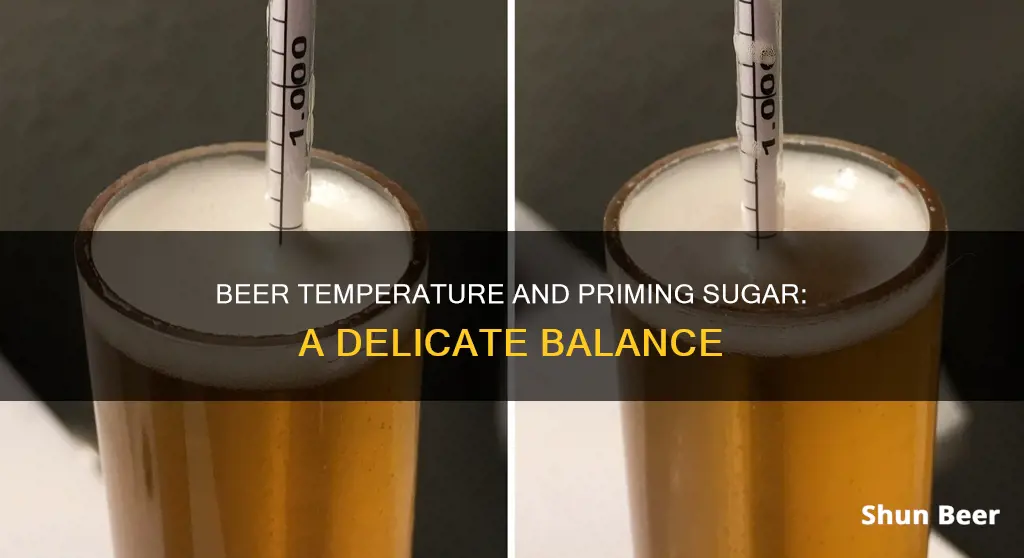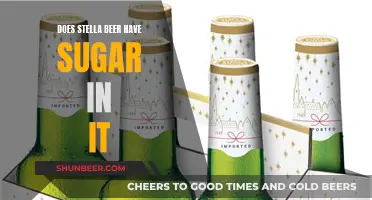
The temperature of beer affects priming sugar because of Henry's Law, which states that cold liquid will absorb more CO2. The amount of CO2 absorbed depends on the fermentation temperature, as CO2 is a byproduct of fermentation and will saturate the beer at that temperature. Higher temperatures can also stress the yeast, affecting carbonation and producing off-flavours. Therefore, the ideal temperature range for carbonation is between 15-25°C for about two weeks, followed by storage in a cool location.
What You'll Learn

Fermentation temperature vs bottling temperature
The temperature of beer during fermentation and bottling can significantly impact the carbonation and flavour of the final product. Fermentation temperature plays a crucial role in the stylistic accuracy of the beer, affecting the yeast's performance and the resulting flavour and aroma compounds. On the other hand, bottling temperature influences the amount of carbonation retained in the beer.
Fermentation Temperature:
Fermentation temperature is the main differentiator between creating ales and lagers. Ale yeast typically performs best at warmer temperatures, ranging from 68 to 72 °F (20 to 22 °C), while lager yeast prefers cooler temperatures, ranging from 45 to 55 °F (7 to 13 °C).
Controlling fermentation temperature is essential for achieving the desired flavour profile. Higher temperatures generally accelerate fermentation and increase the production of byproducts like esters and fusels, which can contribute to undesirable flavours. For example, temperatures above 80 °F (27 °C) can result in excessive fruity-flavoured esters or harsh-flavoured fusel alcohols. On the other hand, fermenting at lower temperatures can lead to slower fermentation and a decrease in flavour and aroma expression.
Some yeast strains, like Kveik yeast, are known for their ability to ferment at very high temperatures (>90 °F) without producing off-flavours. These strains were historically selected for their ability to make delicious beer in warm climates.
Bottling Temperature:
Bottling temperature does not directly impact the flavour of the beer but rather affects the amount of carbonation retained. According to Henry's Law, cold liquid will absorb more CO2. Therefore, the amount of priming sugar required to achieve the desired carbonation level is temperature-dependent.
However, it is important to note that the amount of CO2 absorbed during bottling is dependent on the fermentation temperature, as CO2 is a byproduct of fermentation and will saturate the beer at that temperature. Lowering the temperature during bottling does not introduce more gas but rather brings the available CO2 into solution.
To ensure accurate priming, it is recommended to use the highest temperature the beer reached post-fermentation when calculating the amount of priming sugar needed. This ensures that any CO2 lost due to warming is accounted for, as excess CO2 is lost through the airlock once fermentation is complete.
Sweetening Success: Corn Sugar for Beer Brewing
You may want to see also

CO2 absorption
The temperature of beer does affect CO2 absorption, and thus the amount of priming sugar required. According to Henry's Law, cold liquids absorb more CO2. Therefore, the amount of priming sugar needed depends on the temperature of the beer. However, it is important to note that the amount of CO2 absorbed depends on the fermentation temperature rather than the bottling temperature. This is because CO2 is a byproduct of fermentation, and it saturates the beer at the fermentation temperature.
During the fermentation process, the warmer the brew is stored, the faster the carbonation will be completed. Carbonation can be considered a mini fermentation, so it is ideal to have it completed at a similar temperature to the brewing temperature. For example, for an ale yeast, the ideal temperature range for carbonation is between 15°C and 25°C. If the temperature is too high, it can damage the yeast and affect carbonation. For ale yeast, a temperature above 22°C can produce "off-flavours", while for lager yeast, temperatures above 30°C can be harmful and start killing the yeast.
Additionally, higher temperatures can accelerate the formation of aldehydes, leading to paper flavours. Therefore, once carbonation is complete, it is recommended to move the bottle to a cooler location for long-term storage. While some flavour formation can occur during bottle fermentation, it is minimal, and a cooler conditioning temperature can be maintained without affecting the taste.
Sugar in Beer: Added After Fermentation?
You may want to see also

Off-flavours at high temperatures
When brewing an ale, it is important to keep the temperature between 15-25°C, ideally 18-20°C, to prevent off-flavours from developing. Anything over 22°C for an ale yeast or over 30°C for a lager yeast will cause the yeast to produce 'off-flavours'.
Higher temperatures can stress the yeast, producing off-flavours such as esters or higher alcohols. While these may be a desired flavour profile for certain styles of beer, they are still considered off-flavours. Warmer temperatures also accelerate the formation of aldehydes by the strecker reaction, creating paper flavours.
To avoid these off-flavours, it is recommended to keep the beer at the ideal temperature for around 10 days, and then store it somewhere cool for the long term.
Beers' Surprising Impact: Lowering Blood Sugar, How Many?
You may want to see also

Yeast damage
Yeast is an essential microorganism in the beer-making process. It is responsible for converting sugars into alcohol and carbon dioxide, which gives beer its carbonation and alcoholic content. However, yeast is also sensitive to temperature changes, and extreme temperatures can damage or kill yeast cells, affecting the fermentation and carbonation processes.
Water temperatures above 120°F (48.9°C) can critically injure or kill yeast. At these high temperatures, the yeast cells start to die, and the yeast population will be significantly reduced, impacting the fermentation process. Even temperatures above 95°F (35°C) can put the yeast under stress and cause it to produce less favourable flavours.
On the other hand, extremely cold temperatures can also be detrimental to yeast. While yeast can survive freezing temperatures, it is not in an active state and will not be able to ferment wort effectively. Therefore, it is essential to pitch yeast at the recommended fermentation temperature range for the specific yeast strain to ensure optimal activity and flavour production.
The ideal temperature range for ale yeast fermentation is between 15°C and 25°C. At these temperatures, the yeast will be healthy and active, producing the desired flavour profiles. However, if the temperature exceeds 22°C, the yeast may start to produce "off-flavours" as it becomes stressed. Additionally, storing the beer warmer will accelerate the formation of aldehydes, resulting in paper-like flavours.
For lager yeast, the temperature threshold is lower. Temperatures above 30°C can be harmful and start killing off the yeast. Therefore, it is crucial to maintain the appropriate temperature range during fermentation to avoid yeast damage and ensure a successful beer-making process.
Beer and Blood Sugar: How Three Beers Affect You
You may want to see also

Carbonation time
The ideal temperature range for carbonating beer is between 68-80°F (20-27°C). Warmer temperatures will speed up the carbonation process, while cooler temperatures will slow it down. However, it is important to note that temperatures that are too high can damage the yeast and affect carbonation negatively. For ale yeast, temperatures above 38°C will start to harm the yeast, and for lager yeast, temperatures above 30°C can be harmful. Therefore, it is recommended to carbonate ale at a temperature range of 15-25°C and lager within a range of 5-25°C.
The type of sugar used for priming can also impact carbonation time. Corn sugar, also known as dextrose, is a simple sugar that yeast can easily convert into CO2 in a short time. Table sugar, or sucrose, is another option, but it is a disaccharide, which means yeast will have to work harder to split the two-bond sugar molecule, potentially resulting in stressed and weak yeast that produces off-flavours. Other options for priming sugar include honey, maple syrup, and dry malt extract (DME). However, these alternatives can take longer to ferment and may affect the flavour and aroma of the beer.
The amount of priming sugar added to the beer also influences carbonation time. The general guideline is to use 3/4 cup (177 grams) of corn sugar per 5-gallon batch to achieve 2.25-2.5 volumes of CO2. However, if a higher or lower level of carbonation is desired, measurements must be taken to determine the appropriate amount of sugar. Online calculators and brewing software can be used to calculate the required amount of priming sugar based on the desired carbonation level and the beer's temperature and volume.
The beer's temperature during carbonation is crucial, as it affects the amount of CO2 that can be dissolved in the beer. Colder liquids can hold more CO2, and the CO2 will be released when the liquid is warmed. Therefore, the finished beverage should be stored at colder temperatures to ensure more residual CO2 is in the solution, preventing over-carbonation.
Bottle conditioning is a natural carbonation process that involves adding a priming solution (water and sugar) to flat beer before bottling to initiate a "re-fermentation." The bottles are then stored at 70-75°F (21-24°C) for 2-3 weeks or until fully carbonated. After this, the bottles can be chilled or stored below 60°F (15°C) to stabilize the beer.
Overall, the carbonation time for beer can vary depending on the type of beer, the temperature of carbonation, the type and amount of priming sugar used, and the method of carbonation (bottle conditioning or force carbonation). By controlling these factors, brewers can achieve the desired level of carbonation and flavour in their beer.
Kick Sugar, Quit Beer: A Guide to Breaking Free
You may want to see also
Frequently asked questions
The amount of CO2 that can be dissolved in beer is dependent on temperature. Cooler temperatures allow more CO2 to be dissolved, whereas warmer temperatures allow less.
The bottling temperature does not matter for the amount of CO2 absorbed, as CO2 is a byproduct of fermentation and will saturate the beer at the fermentation temperature.
The ideal temperature for priming sugar is between 15-25°C for about 10 days, followed by storage in a cool location.







